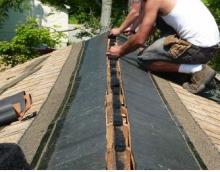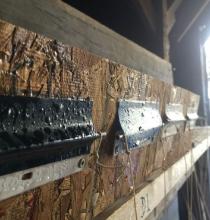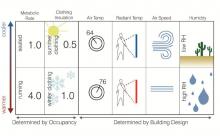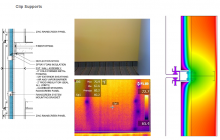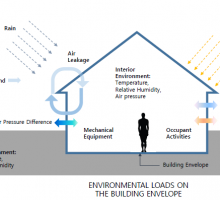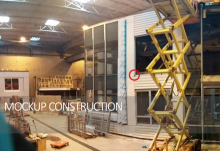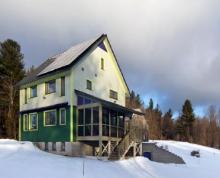Building envelope
Roofs: Research and Reality
To vent or not to vent? To insulate outboard or inboard? To provide details or just let contractors wing it? These are some of the questions two pros, who spend a good portion of their work days crawling around on roofs (of both wood framed and masonry buildings), will address. They will share case studies of roof failures; go over edge and penetration details that are so critical for long-term durability; discuss how to take advantage of opportunities to improve thermal performance; and share some of the latest geeky research, including how to do an unvented assembly without code-mandated spray foam. You’ll leave this session knowing what works, what doesn't, and how to juggle budgetary, design or building constraints to build durable, low-risk roofs.
Sticky Business: The Truth About Tapes and What It Means for Your Enclosure
Pressure sensitive tapes (PSAa) can make or break the continuity of your air and weather barrier—ensuring a durable, high performing enclosure, or putting it at risk. Yet we have little way of knowing whether tapes will stand the test of time. We can’t visually inspect them once the cladding goes up. Nor can we rely on existing testing standards, which aren't suitable for the products used in construction and the cold, windy, wet, dirty conditions in which they are installed. Three years ago Peter and Dave took matters in to their own hands, setting up a testing facility to measure the performance of routinely installed products under field conditions. They will share the results of their testing and what it means for field practitioners.
Retrofit Like You Give a Sh*t: Inspiring Homeowners to Care about Efficiency
You care about the environment, climate change and sustainability. You want to do your part to make existing homes more energy efficient. But all your customers want are new kitchens, better bathrooms and big additions. What can you do? How can you help homeowners learn to value what they can’t see and begin to understand their house as a system? And equally important, how can you, on a limited budget, and in piecemeal fashion, move a house systematically toward greater energy efficiency? In this panel discussion, we’ll cover the following: educating homeowners about energy efficiency and the house as a system; making a long-term plan for energy upgrades over time; working incrementally to improve a home’s energy efficiency; and insuring that the way is clear for those who follow you.
What Contractors Need to Know About Spray Foam
Spray foam is an essential tool in the high performance building toolbox, yet many builders have concerns about using the material including subpar installations; how to protect workers, occupants and spaces outside the spray zone; offgassing; the global warming potential of blowing agents, and even foam failures. In this session Kerry Koskinen, a seasoned remodeler, will interview Henri Fennell, a leading spray foam expert about what contractors need to know and to do to ensure safe, high quality installations. Common problems will be addressed as well as strategies for avoiding them. The session will conclude with an extended Q&A, so attendees are encouraged to come with questions.
Room-side Low-e Coating: As Good as It Sounds?
The selection of a glazing type for a project is based on factors like thermal performance, impact on occupant thermal comfort and cost. Double pane glazing units with a room-side low-e coating are becoming popular, because their thermal properties and visual appearance are comparable to those of a triple pane unit, but at a lower cost. However, the impact of selecting one over the other can have significant impact on seasonal thermal comfort conditions, and the wrong choice could lead to a need for perimeter heating as a remedial measure. This session addresses the benefits and drawbacks of using double pane glass with a room-side low emissivity coating as a substitute to a more expensive and heavier triple pane unit. In order to ensure no perimeter heating is necessary with either unit, we introduce a method to quantify two factors affecting occupant thermal comfort: radiant temperatures and risk of downdraft.
Break It or Lose It: Thermal Bridging in Building Envelopes
While thermal bridging is widely acknowledged to exist in modern commercial building envelopes, little is known on the significance of its impact. Utilizing infrared images taken from targeted assemblies at 15 recently completed buildings; we have seen a range up to 70% less than the design intended R-value. This range shows the unintended impact that design details can have on thermal performance.
We identified 16 common areas of thermal bridging that were frequently observed in the buildings surveyed. Broken into two broad categories of façade systems and transitions / penetrations, they range from curtain wall systems, to existing wall renovations, to conditions such as parapets and transitions to foundation.
The outcome of this research is a better understanding of thermal performance of commercial façades in order to help architects and building professionals understand the real impact of common thermal bridges and present alternatives to the industry standards that enhance performance.
A Prototype Visualization Tool for Hygrothermal Analysis
Recent developments in the field of building simulation and computing power are allowing architects to effectively move performance analysis of designs into the early stages of the design process. These developments aim to allow for the rapid iteration of design solutions that examine various performance criteria. This presentation describes a prototype tool that can serve as a platform to merge large amounts of building performance simulation data coupling various performance criteria. A case study using the prototype tool that uses WUFI engine to simulate moisture movement and analyze the related risk for mold growth and for building component failure using ASHRAE standards. The conclusions show that key insights can be quickly obtained using this tool, demonstrating its potential to increase our understanding of building performance. It also lays the groundwork for a more seamless integration of hygrothermal modeling into the whole building analysis process.
Air Leakage: What You See is Not What You Get
Air leakage is an important consideration in all construction. Tighter buildings are more energy efficient and comfortable. Although large buildings are rarely blower door tested, architects, enclosure consultants, manufacturers, and installers spend time and money to provide air tight buildings. Details within the contract documents and subsequent shop drawings indicate the intended location of the air barrier. However, over the course of mockup construction, mockup testing, and project construction, air leakage issues often arise that were not addressed prior, generally at unusual conditions and transitions. These locations can be difficult to detail and are typically overlooked. This presentation will first review the basics of air leakage detailing, and then provide specific examples where project documentation did not address air leakage sites, which were found in the field. Implemented field fixes will also be presented. Although project-specific, these case studies will demonstrate typical locations that must be carefully vetted during detailing.
How We Sleep at Night - Energy Metrics and Decision Making in Residential Design
PHI stands by 4.75kbtu/sq ft/yr for AHD. PHIUS has recently reworked its performance standard. Energy Star now has Version III. Living Building Challenge requires net zero. Green building standards require differing guidance on annual heat demand and peak load. Learn from long time practitioners with experience in climate zones 5, 6 and 7 as they discuss their sweet spots for appropriate metrics in peak load and AHD. Laugh while the moderator mocks, tugs and cajoles the experts while teasing out the answers to life’s persistent questions (according to energy geeks).
When You Come to a Fork, Take It. Residential Choices and Performance
Decisons, decisions. Residential design is always part education, part therapy, and part architecture. This panel will showcase the work of two designers and a builder who have climbed high on the residential decision-making tree. Architect Chris Briley will explore the challenges of two Passive House projects, in the same climate, with different clients, as he worked with each to come to different conclusions and different strategies for the same high performance target. Jesse Selman and Kent Hicks (architect and builder) will discuss the complex process of navigating the sometimes conflicting goals of high performance, thoughtful design, and the needs of a client with an existing building, a beautiful site, and multiple chemical sensitivities.

